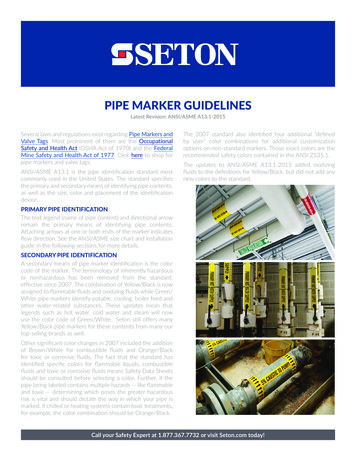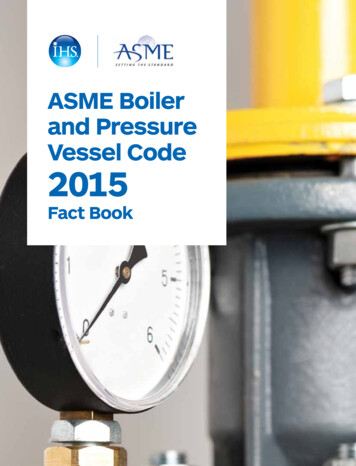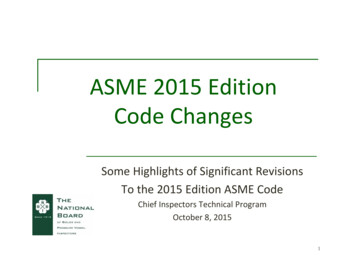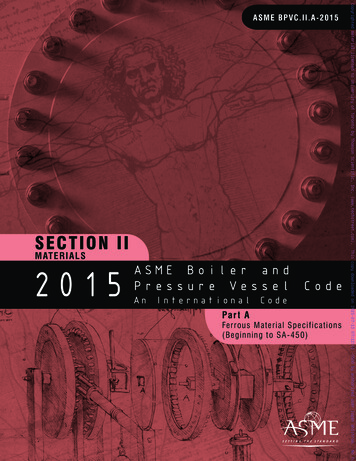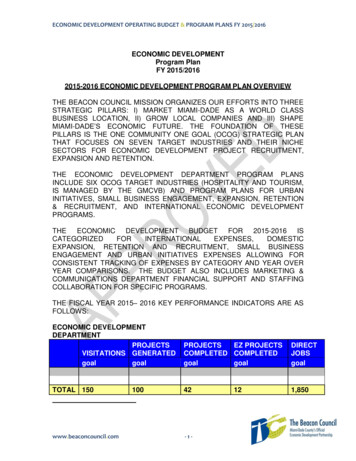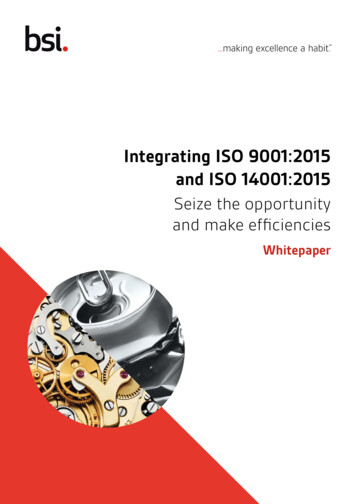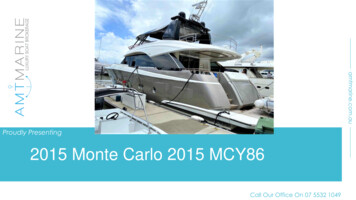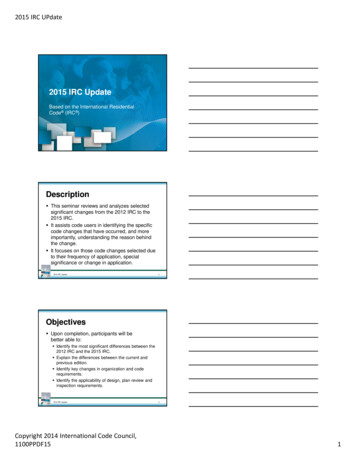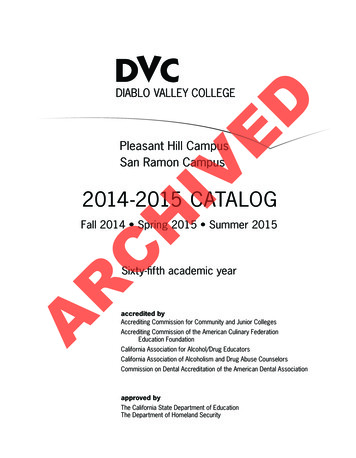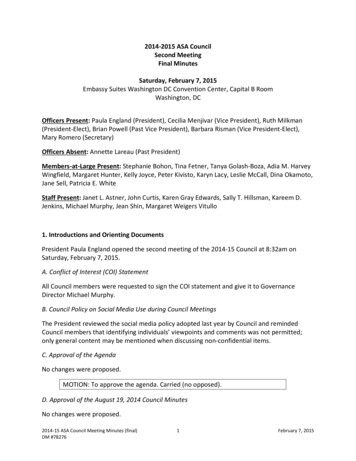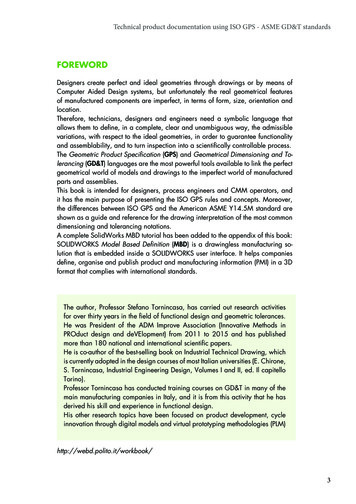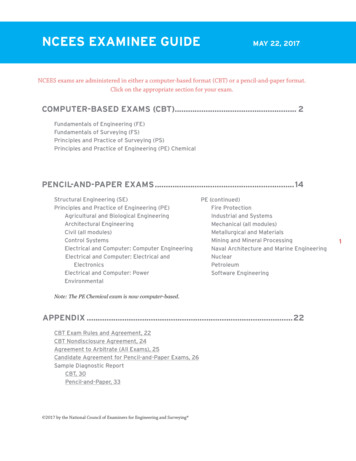
Transcription
2015GO.ASME.ORG / BPVC15Boiler and Pressure Vessel CodeAN INTERNATIONAL CODEThe American Society of Mechanical Engineers (ASME)
SETTING THESTANDARD FOR THENEXT 100 YEARSFOR DETAILS, CALL 1-800-THE-ASME (1-800-843-2763) (OR) 1-973-882-1170 (OR) VISIT GO.ASME.ORG/BPVC15.
BOILERS ANDPRESSURE VESSELSSince its first issuance in 1914,ASME’s BPVC has pioneered modernstandards-development, maintaining acommitment to enhance public safetyand technological advancement to meetthe needs of a changing world. This“International Historic MechanicalEngineering Landmark” now has beenincorporated into the laws of state andlocal jurisdictions of the United Statesand nine Canadian provinces.Please note: ASME’s Boiler and PressureVessel Code (BPVC) begins it bi-annualpublishing cycle with this Edition in 2015.User feedback was clear that assimilatingall the changes every two years wouldspare the need for yearly changes throughaddenda; and produce a more userfriendly reference that eliminates theneed for interfiling of replacement pages.ASME issued its first Standard, Code forthe Conduct of Trials of Steam Boilers, in1884. This paper evolved into Rules for theConstruction of Stationary Boilers and forAllowable Working Pressure – the firstedition of ASME’s now-legendary Boilerand Pressure Vessel Code (BPVC) – issuedin 1914 and published in 1915.The BPVC has grown over the decades toinclude 31 books and 17,000 pages coveringindustrial and residential boilers as wellas nuclear reactor components, transporttanks, and other forms of pressurevessels. It is kept current by nearly 1,000volunteer technical experts – drawn froma balance of interests among industry,government and R&D – who operate in afully open and transparent manner viaconsensus process.NUCLEARASME has played a vital role insupporting the nuclear industry since itsinception, when ASME codes, standardsand conformity assessment programs,originally developed for fossil fuel-firedplants, were applied to nuclear powerplant construction. Its widely-adoptedBPVC Section III, Rules for Constructionof Nuclear Facility Components, celebrated50 years in 2013.Presently, half of the world’s nuclearpower plants incorporate all or portionsof ASME nuclear codes and standards intheir construction, operation, and/ormaintenance. Sixty nations generallyrecognize and apply the BPVC, while 30of the 44 nuclear nations purchase theirnuclear components to specificationscontained within ASME’s nuclear codesand standards. The nuclear sections ofthe BPVC reflect the best-practices ofindustry, while contributing to morethan a half-century of safety for thegeneral public.ASME’S BOILER AND PRESSURE VESSEL CODE (BPVC) 2015The BPVC is in use in 100 countriesaround the world, with translationsinto a number of languages. The boilerand pressure-vessel sections of the BPVChave long been considered essentialwithin such industries as electricpower-generation, petrochemical, andtransportation, among others.Visit go.asme.org/BPVC15The resulting “living document” remainsa worldwide model for assuring thesafety, reliability and operationalefficiency first envisioned by ASME’sfounders more than a century ago.1
POWER BOILERSSECTION IPOWER BOILERSProvides requirements for all methodsof construction of power, electric, andminiature boilers; high temperaturewater boilers, heat recovery steamgenerators, and certain fired pressurevessels to be used in stationary service;and power boilers used in locomotive,portable, and traction service. Rulespertaining to use of the single ASMEcertification mark with the V, A, M, PP, S,and E designators are also included.Seccion I – Reglas para la construccionde calderas de energia (BPVC-I ES – 2010).SECTION VIICARE OF POWER BOILERSProvides guidelines to assist thosedirectly responsible for operating,maintaining, and inspecting powerboilers. These boilers include stationary,portable, and traction type boilers, butnot locomotive and high-temperaturewater boilers, nuclear power-plant boilers(see Section XI), heating boilers (seeSection VI), pressure vessels, or marineboilers. Guidelines are also provided foroperation of auxiliary equipment andappliances that affect the safe andreliable operation of power boilers.REFERENCEDBPVC SECTIONSBPVC-II, A, B, C,DSection II, Materials, Parts A through D.BPVC-VSection V, Nondestructive Examination.BPVC-VIII-1Section VIII, Rules for Construction ofPressure Vessels, Division 1.BPVC-IXSection IX, Welding, Brazing, andFusing Qualifications.REFERENCEDASME STANDARDSB1.20.1Pipe Threads, General Purpose, Inch.Twelve Standards from the B16 Serieson pipe flanges and fittings.B31.1Power Piping.B36.10MWelded and Seamless Wrought Steel Pipe.PTC 25Pressure Relief Devices.QAI-1Qualifications for Authorized Inspection.
HEATING BOILERSSECTION IV – HEATING BOILERSSECTION VI – CARE ANDOPERATION OF HEATING BOILERSCovers operation guidelines applicableto steel and cast-iron boilers limitedto the operating ranges of Section IVHeating Boilers. Section VI includesguidelines for associated controls andautomatic fuel-burning equipment.Also included is a glossary of termscommonly associated with boilers,controls, and fuel-burning equipment.REFERENCED BPVC SECTIONSBPVC-ISection I, Rules for Construction ofPower BoilersBPVC-II, A, B, C, DSection II, Materials, Parts A through DBPVC-IXSection IX, Welding, Brazing, and FusingQualificationsASME’S BOILER AND PRESSURE VESSEL CODE (BPVC) 2015Provides requirements for design,fabrication, installation and inspectionof steam heating, hot water heating,hot water supply boilers, and potablewater heaters intended for low pressureservice that are directly fired by oil, gas,electricity, coal or other solid or liquidfuels. Rules pertaining to use of the singleASME certification mark with the H, HV,and HLW designators are also included.REFERENCED ASME STANDARDSSeven Standards from the B16 Series onpipe flanges and fittingsPTC 25Pressure Relief DevicesQAI-1Qualifications for Authorized Inspection3
PRESSURE VESSELSREFERENCEDBPVC SECTIONSSECTION VIIIPRESSURE VESSELSDivision 1 provides requirementsapplicable to the design, fabrication,inspection, testing, and certification ofpressure vessels operating at eitherinternal or external pressures exceeding15 psig. Such vessels may be fired orunfired. This pressure may be obtainedfrom an external source or by theapplication of heat from a direct orindirect source, or any combinationthereof. Specific requirements apply toseveral classes of material used inpressure vessel construction, and also tofabrication methods such as welding,forging and brazing.Division 1 contains mandatory andnon-mandatory appendices detailingsupplementary design criteria,nondestructive examination andinspection acceptance standards. Rulespertaining to the use of the single ASMEcertification mark with the U, UM andUV designators are also included.Division 2 requirements on materials,design, and nondestructive examinationare more rigorous than in Division 1;however, higher design stress intensityvalues are permitted. These rules mayalso apply to human occupancy pressurevessels typically in the diving industry.Rules pertaining to the use of the singleASME certification mark with the U2 andUV designators are also included.Division 3 requirements are applicable topressure vessels operating at eitherinternal or external pressures generallyabove 10,000 psi. It does not establishmaximum pressure limits for eitherSection VIII, Divisions 1 or 2, nor minimumpressure limits for this Division. Rulespertaining to the use of the single ASMEcertification mark with the U3 and UV3designator are also included.BPVC-II, A, B, C, DSection II, Materials, Parts A through D.BPVC-VSection V, Nondestructive Examination.BPVC-IXSection IX, Welding, Brazing, andFusing Qualifications.ASME’S PRESSURETECHNOLOGY BOOKSApplicable to pressure equipmentStandards.ASME Section VIII Division 2 Criteria andCommentary (PTB-1 - 2014).Guide to Life Cycle Management ofPressure Equipment Integrity(PTB-2 - 2009).ASME Section VIII-Division 2 ExampleProblem Manual (PTB-3 - 2013).ASME Section VIII-Division 1 ExampleProblem Manual (PTB-4 - 2013).ASME Section VIII-Division 3 ExampleProblem Manual (PTB-5 - 2013) .Guidelines for Strain Gaging of PressureVessels Subjected to External PressureLoading in the PVHO-1 Standard(PTB-6 - 2013).Criteria for Shell-and-Tube HeatExchangers According to Part UHX ofASME Section VIII-Division 1(PTB-7 - 2014).Procurement Guidelines for MetallicMaterials (PTB-8 - 2014).FOR DETAILS, CALL 1-800-THE-ASME (1-800-843-2763) (OR) 1-973-882-1170 (OR) VISIT GO.ASME.ORG/BPVC15.
DIVISION 2API 579-1/ASME FFS-1Fitness-For-Service.Three Standards from the B1 Series onscrew threads.REFERENCEDASME STANDARDSNine Standards from the B16 Series onpipe flanges and fittings.DIVISION 1Four Standards from the B18 Series onhex bolts.Five Standards from the B1 Series onscrew threads.Thirteen Standards from the B16 Serieson pipe flanges and fittings.Nine Standards from the B18 Series onhex bolts.B36.10MWelded and Seamless Wrought Steel Pipe.B36.10MWelded and Seamless Wrought Steel Pipe.B36.19MStainless Steel Pipe.NQA-1Quality Assurance ProgramRequirements for Nuclear Facilities.PCC-1Guidelines for Pressure Boundary BoltedFlange Joint Assembly.NQA-1Quality Assurance ProgramRequirements for Nuclear Facilities.PTC 25Pressure Relief Devices.QAI-1Qualifications for Authorized Inspection.PCC-1Guidelines for Pressure Boundary BoltedFlange Joint Assembly.PCC-2Repair of Pressure Equipment and Piping.PTC 25Pressure Relief Devices.QAI-1Qualifications for Authorized Inspection.QAI-1Qualifications for Authorized Inspection.DIVISION 3API 579-1/ASME FFS-1Fitness-For-Service.Three Standards from the B1 Series onscrew threads.Four Standards from the B16 Series onpipe flanges and fittings.Seven Standards from the B18 Series onhex bolts.B36.10MWelded and Seamless Wrought Steel Pipe.B46.1Surface Texture (Surface Roughness,Waviness and Lay).ASME’S BOILER AND PRESSURE VESSEL CODE (BPVC) 2015B36.19MStainless Steel Pipe.PTC 25Pressure Relief Devices.QAI-1Qualifications for Authorized Inspection.5
PRESSURE VESSELSSECTION XIITRANSPORT TANKSProvides requirements for constructionand continued service of pressure vesselsfor the transportation of dangerousgoods via highway, rail, air or water atpressures from full vacuum to 3,000 psigand volumes greater than 120 gallons.“Construction” is an all-inclusive termcomprising materials, design, fabrication,examination, inspection, testing,certification, and over-pressure protection. “Continued service” refers toinspection, testing, repair, alteration, andrecertification of a transport tank thathas been in service. Rules pertainingto the use of the single ASME certificationmark with the T, TD, and TV designatorsare included.REFERENCEDBPVC SECTIONSBPVC-II, A, B, C, DSection II, Materials, Parts A through D.BPVC-VSection V, Nondestructive Examination.BPVC-VIII-1-2Section VIII, Pressure Vessels,Division 1 and Division 2.BPVC-IXSection IX, Welding, Brazing,and Fusing Qualifications.REFERENCED ASMESTANDARDSB1.1Unified Inch Screw Threads(UN and UNR Thread Form).B1.20.1Pipe Threads, General Purpose, Inch.Nine Standards from the B16 Series onpipe flanges and fittings.B18.2.2Square and Hex Nuts.B36.10MWelded and Seamless Wrought Steel Pipe.PTC 25Pressure Relief Devices.QAI-1Qualifications for Authorized Inspection.
FIBER-REINFORCED PLASTICPRESSURE VESSELSSECTION X – FIBER-REINFORCEDPLASTIC PRESSURE VESSELSProvides requirements for constructionof a fiber-reinforced plastic pressurevessel (FRP) in conformance with amanufacturer’s design report. It includesproduction, processing, fabrication,inspection and testing methods requiredfor the vessel. Section X includes threeClasses of vessel design: Class I andClass III – qualification through thedestructive test of a prototype; andClass II – mandatory design rules andacceptance testing by nondestructivemethods. These vessels are not permittedto store, handle or process lethal fluids.Vessel fabrication is limited to thefollowing processes: bag-molding,centrifugal casting and filament-windingand contact molding. Rules pertaining tothe use of the single ASME certificationmark with the RP designator arealso included.BPVC-VNondestructive ExaminationReferenced ASME StandardsB16.1Gray Iron Pipe Flanges and FlangedFittings: Classes 25, 125, and 250B16.5Pipe Flanges and Flanged Fittings: NPS1/2 through NPS 24 Metric/Inch StandardB18.22.1Plain WashersASME’S BOILER AND PRESSURE VESSEL CODE (BPVC) 2015REFERENCED BPVC SECTIONS7
CONSTRUCTION OF NUCLEARFACILITY COMPONENTSDIVISION 1, SUBSECTIONS NC, NDSubsection NC addresses items, which areintended to conform to the requirementsfor Class 2 construction.Subsection ND addresses items, which areintended to conform to the requirementsfor Class 3 construction.Subsection NE addresses items, which areintended to conform to the requirementsfor Class MC construction.Division 2 addresses concretecontainment structures, pre-stressed orreinforced. These requirements areapplicable only to those components thatare designed to provide a pressureretaining or containing barrier.Subsection NF addresses the supports,which are intended to conform to therequirements for Classes 1, 2, 3, and MCconstruction.Division 3 addresses the design andconstruction of the containment systemof a nuclear spent fuel or high levelradioactive waste transport packaging.Subsection NG addresses structures,which are designed to provide directsupport or restraint of the core (fuel andblanket assemblies) within the reactorpressure vessel.Division 5 provides construction rules forhigh-temperature reactors, including bothhigh-temperature, gas-cooled reactors(HTGRs) and liquid-metal reactors (LMRs).OTHER SUBSECTIONS AND DIVISIONSSECTION IIIRULES FOR CONSTRUCTION OFNUCLEAR FACILITY COMPONENTSProvides general requirements whichaddress the material, design, fabrication,examination, testing and overpressureprotection of the items specified withineach respective Subsection, assuringtheir structural integrity.Division 1, Subsection NCA SubsectionNCA, which is referenced by and is anintegral part of Division 1, SubsectionsNB through NG, and Division 2 of SectionIII, which covers quality assurancerequirements, ASME product-certification marks, and authorized inspection forClass 1, 2, 3, MC, CS, and CC construction.DIVISION 1, SUBSECTIONS NB, NF, APPSubsection NB addresses items which areintended to conform to the requirementsfor Class 1 construction.Subsection NF addresses supportswhich are intended to conform to therequirements for Classes 1, 2, 3, and MCconstruction.Subsection APP contains appendices,both mandatory and non-mandatory forSection III, Division 1 (Subsections NCAthrough NG), Division 2 and Division 3,including a listing of design and designanalysis methods and information, plusData Report Forms. These appendices arereferenced by, and are an integral part of,Subsections NCA through NG, Division 2and Division 3.Subsection NH addresses Class 1components, parts, and appurtenanceswhich are expected to function evenwhen metal temperatures exceed thosecovered by the rules and stress limits ofSubsection NB and Tables 2A, 2B, and 4 ofSection II, Part D, Subpart 1.REFERENCED BPVC SECTIONSBPVC-II, A, B, C, DSection II, Materials, Parts A through D.BPVC-VSection V, Nondestructive Examination.BPVC-IXSection IX, Welding, Brazing, and FusingQualifications.BPVC-XISection XI, Rules for Inservice Inspectionof Nuclear Power Plant Components.REFERENCED ASME STANDARDSThree Standards from the B1 Series onscrew threads.Eight Standards from the B16 Series onpipe flanges and fittings.Three Standards from the B18 Series onhex bolts.B36.10MWelded and Seamless Wrought Steel Pipe.B36.19MStainless Steel Pipe.NQA-1Quality Assurance ProgramRequirements for Nuclear Facilities.QAI-1Qualifications for Authorized Inspection.FOR DETAILS, CALL 1-800-THE-ASME (1-800-843-2763) (OR) 1-973-882-1170 (OR) VISIT GO.ASME.ORG/BPVC15.
NUCLEAR INSERVICESECTION XIRULES FOR INSERVICEINSPECTION OF NUCLEAR POWERPLANT COMPONENTSContains Divisions 1 and 3, in one volume,and provides rules for the examination,inservice testing and inspection, andrepair and replacement of componentsand systems in light water cooled andliquid metal cooled nuclear power plants.Application of Section XI begins when therequirements of the “construction code”(e.g., Section III) have been satisfied.REFERENCED ASME STANDARDSBPVC-II, A, B, C, DSection II, Materials, Parts A through D.NQA-1Quality Assurance Requirements forNuclear Facilities Applications (QA).BPVC-IIISection III, Rules for Construction ofNuclear Facility Components:Subsection NCA, General Requirementsfor Division 1 and Division 2.Subsection NB, Class 1 Components.Subsection NC, Class 2 Component.Subsection ND, Class 3 Components.Subsection NE, Class MC Components.Subsection NF, Supports.Subsection NG, Core Support Structures.Subsection NH, Class 1 Components inElevated Temperature Service.Appendices.Division 2-Code for ConcreteContainments.Division 3-Containments forTransportation & Storage of SpentNuclear Fuel and High Level RadioactiveMaterial & Waste.Division 5, High Temperature Reactors.BPVC-VSection V, Nondestructive Examination.BPVC-VIII-1-2Section VIII, Pressure Vessels, Division 1and Division 2.QAI-1Qualifications for Authorized Inspection.RA-SStandard for Level 1 / Large Early ReleaseFrequency Probabilistic Risk Assessmentfor Nuclear Power Plant Applications.NQA-1Quality Assurance Requirements forNuclear Facility Applications (QA).Provides requirements and guidelines forthe establishment and execution ofquality assurance programs during siting,design, construction, operation anddecommissioning of nuclear facilities.This Standard reflects industryexperience and current understanding ofthe quality assurance requirementsnecessary to achieve safe, reliable, andefficient utilization of nuclear energy, andmanagement and processing ofradioactive materials.NQA-1 focuses on the achievement ofresults, and emphasizes the role of theindividual and line management in theachievement of quality. It fosters theapplication of these requirements in amanner consistent with the relativeimportance of the item or activity.ASME’S BOILER AND PRESSURE VESSEL CODE (BPVC) 2015Section XI constitutes requirements tomaintain the nuclear power plant while inoperation and to return the plant toservice, following plant outages, andrepair or replacement activities. Theserules require a mandatory program ofscheduled examinations, testing, andinspections to evidence adequate safety.The method of nondestructiveexamination to be used and flaw sizecharacterization are also containedwithin this Section.REFERENCED BPVC SECTIONSBPVC-IXSection IX, Welding, Brazing, and FusingQualifications.9
SERVICE SECTIONSSECTION II – MATERIALSPart A covers Ferrous Material; Part Bcovers Nonferrous Material; Part Ccovers Welding Rods, Electrodes, andFiller Metals; and Part D covers MaterialProperties in both Customary andMetric units of measure.Together, these four parts of Section IIcomprise a “service Code” to other BPVCSections, providing material specifications adequate for safety in the field ofpressure equipment. These specificationscontain requirements for chemical andmechanical properties, heat treatment,manufacture, heat and product analyses,and methods of testing. Part A and Part Bspecifications are designated by SA or SBnumbers, respectively, and are identicalwith or similar to those of specificationspublished by ASTM and other recognizednational or international organizations.Part C specifications are designatedby SFA numbers and are derived fromAWS specifications.SECTION VNONDESTRUCTIVE EXAMINATION Is another “service Code” – containingrequirements and methods for nondestructive examination which arereferenced and required by otherBPVC Sections. It also includes manufacturer’s examination responsibilities,duties of authorized inspectors andrequirements for qualification ofpersonnel, inspection and examination.Examination methods are intended todetect surface and internal discontinuities in materials, welds, and fabricatedparts and components. A glossary ofrelated terms is included.SECTION IXWelding, Brazing, and FusingQualifications Is another “service Code” – containingrules relating to the qualification ofwelding, brazing, and fusing proceduresas required by other BPVC Sections.It also covers rules relating to thequalification and requalification ofwelders, brazers, and welding and brazingoperators in order that they mayperform welding or brazing in componentmanufacture. Welding, brazing andfusing data cover essential andnonessential variables specific to thewelding, brazing or fusing process used.CODE CASES PRESSURETECHNOLOGY / NUCLEARStarting with this 2015 Edition, theBPVC will be revised every two years. Butwhat happens in the interim with newmaterials or alternative constructions?How does the BPVC keep current with thelatest in technology and applications?Code Cases are approved actions by theBPVC Committees on these alternatives,intended to allow early and urgentimplementation of any revisedrequirements. They are issued four timesper year in two categories: Boiler andPressure Vessels (CC-BPV) and Nuclear(CC-NUC). Users may purchase individualpublications at any time. Or they maysubscribe to receive full sets of CodeCases as they are published for theduration of that BPVC edition’s cycle.This responsiveness to requests illustratesthe unique openness and transparency ofASME’s code-development process –striving to reflect best-practices ofindustry, while contributing to safety forthe general public.
ASME’S BOILER AND PRESSURE VESSEL CODE (BPVC) 201511
ASME CONFORMITYASSESSMENT – BECAUSEYOU HAVE HIGH STANDARDSCurrently, there are more than 7,000ASME certificate holders in 75 countries.As of August 2014SECTION IPOWER BOILERSASME’s product certification programsqualify the manufacture or assemblyof a company’s products to ASMEstandards. These programs are designedto enhance public safety and facilitateinternational commerce.“S” Designator – Power BoilersManufacturers who achieve productcertification by ASME may:“M” Designator – Miniature Boilers Increase the quality and safety oftheir products Enable business in the globalmarketplace Achieve production efficiencies Use an ASME Certification Mark ontheir product*Visit go.asme.org/CERTIFICATIONS*Not all product certifications include anASME designator.BOILER AND PRESSUREVESSEL CERTIFICATIONThe ASME BPV Certification Programconforms to the rules governing thedesign, fabrication, assembly, andinspection of boiler and pressure vesselcomponents during construction. In 1916,shortly after the first publication of theRules for the Construction of StationaryBoilers and for Allowable WorkingPressures, known today as the ASMEBPVC, ASME began offering certificationto companies in the pressure equipmentindustry to certify their quality controlsystems. Products manufactured byASME BPV Certificate Holders are certifiedand stamped with the Certification Mark(a.k.a., Designator or Stamp) in accordancewith the applicable ASME BPVC Section.“A” Designator – Assembly of Power BoilersSECTION VIIIDIVISION 2PRESSURE VESSELS“U2” Designator – Pressure Vessels(Alternative Rules for Pressure Vessels)“E” Designator – Electric Boilers“PP” Designator – Pressure Piping“V” Designator – Boiler Safety Relief ValvesSECTION IV – HEATING BOILERS“H” Designator – Heating Boilers“HLW” Designator – Lined PotableWater Heaters“HV” Designator – Heating Boiler SafetyRelief ValvesSECTION VIIIDIVISION 1PRESSURE VESSELS“U” Designator – Pressure Vessels“UM” Designator – MiniaturePressure Vessels“UV” Designator – Pressure VesselPressure Relief Valves“UD” Designator – Pressure Vessel RuptureDisk DevicesSECTION VIII DIVISION 3PRESSURE VESSELS“U3” Designator – High Pressure Vessels“UV3” Designator – High Pressure VesselPressure Relief Valves“UD3” Designator – High Pressure VesselPressure Rupture Disk Devices (New)SECTION XFIBER-REINFORCEDPLASTIC VESSELS“RP” Designator – Fiber-ReinforcedPlastic VesselsSECTION XIITRANSPORTS TANKS“T” Designator – Transport Tanks“TV” Designator – Transport TanksPressure Relief Valves“TD” Designator – Transport TanksPressure Relief DevicesFOR DETAILS, CALL 1-800-THE-ASME (1-800-843-2763) (OR) 1-973-882-1170 (OR) VISIT GO.ASME.ORG/BPVC15.
NUCLEAR COMPONENTCERTIFICATIONNUCLEAR MATERIALORGANIZATION CERTIFICATIONNuclear-type Certificates ofAuthorization issued by ASME verify theadequacy of an organization’s qualityassurance program and allow theCertificate Holder to design, fabricate, andinstall components and supports used innuclear power plants and other nuclearfacilities. These components will becertified and stamped with theCertification Mark in accordance withSection III of the ASME BPVC.The Nuclear Material OrganizationCertification Program certifiesorganizations that provide materialsand services to the nuclear powerindustry. The rules for this certificationprogram were first introduced in the 1973Winter Addenda of the ASME BPVC forMaterial Manufactures and MaterialSuppliers, which currently are referred toas Material Organizations.N – Vessels, pumps, valves, pipingsystems, storage tanks, core supportstructures, concrete containments,and transport packagingNA – Field installation and shopassembly of all itemsQuality System Certificates (QSC) issuedby ASME verify the adequacy of aMaterial Organization’s quality systemprogram. This quality system programprovides assurance that the organization’s operations, processes, and servicesrelated to the procurement, manufacture,and supply of material, source material,and unqualified source material areperformed in accordance with therequirements of the ASME BPVC,Section III, NCA-3800 and NCA-3900.NPT – Parts, appurtenances,welded tubular products, andpiping subassembliesNS – SupportsNV – Pressure relief valvesN3 – Transportation containmentsand storage containmentsOWN – Nuclear power plant ownerASME’S BOILER AND PRESSURE VESSEL CODE (BPVC) 2015ASME issues six different N-typecertificates, and an owner’s certificatethat authorizes the following scopeof activities:View the ASME codes and standardsrequired for each certification. Visitgo.asme.org/REQUIREDCODEBOOKS.13
NQA-1 Certification Your QualityBegins With Quality AssuranceEntering the nuclear supply chain can bea daunting and costly task. To supportthe nuclear industry, ASME developed itsnew NQA-1 certification program toassess and certify companies that arecommitted to understanding quality andproducing high-quality products andservices. The ASME NQA-1 certification isdesigned to assess a supplier’s capabilityin implementing a quality assuranceprogram that meets the requirements ofthe NQA-1 Standard.Suppliers who achieve NQA-1certification, may:“When potential clients hearthat our quality assuranceprogram has been certified byASME, it’s automatic for them tounderstand what requirementsthe program meets. Premier’sbusiness opportunities havegrown exponentially since weachieved our NQA-1 certification.”– Mathew Burke,Quality Assurance Manager, PremierTechnology Inc., Blackfoot, Idaho Gain a competitive edge in themarketplace. Save time and money by reducinglength and frequency of audits. Inspire confidence in the safety of yourcompany and its products.THE NEW CA CONNECTHAS ARRIVEDConformity Assessment At Your Fingertipscaconnect.asme.orgCA Connect, ASME’s online system for managing certification andaccreditation programs, has been completely redesigned with you in mind.The New CA Connect: Is easier to navigateDemonstrates increased speed and performanceImproves the user experienceFor general certification and accreditation information, please visitgo.asme.org/certificationsVisit go.asme.org/NQA-1
VOLUNTEERINGBENEFITS OF VOLUNTEERINGFOR BPVC COMMITTEESFor more than 100 years, ASME hassuccessfully attracted volunteertechnical experts to develop, maintainand disseminate ASME codes andstandards. Participation by volunteers isthe lifeblood of the BPVC.INDIVIDUALSAs a BPVC Committee volunteer, you gain: Early Awareness of critical technicaland regulatory issues that coulddirectly impact your business. Professional Networking with nearly1,000 “best of the best” nucleartechnical experts from across thecountry and around the world.COMPANIESInvolvement on BPVC committeesprovides companies with criticalinformation, plus opportunities toexpand their global networks andstrengthen involvement in the decisionmaking process.Being involved in the development ofASME codes and standards provides earlyand ongoing awareness of technicalissues in industry and how others aredealing with them. This awareness allowsparticipants to avoid these issues withintheir own organizations or to havesolutions prepared should problems arise.ASME also helps governments ensurethe safety of their citizens and theirenvironment through the adoption ofASME codes and standards to satisfyregulation. Use of ASME codes andstandards lessens the burden ongovernment by providing a technicallysound basis for achieving regulatorygoals without imposing an unnecessaryburden on industry. Governmentinvolvement on BPVC committeesprovides officials with criticalinformation and strengthensinvolvement in the decision-makingprocess, so that regulations areunderstood and enforceable.“BOILER CODE WEEKS”The BPVC is kept current by the BPVCCommittee, a volunteer group of nearly1,000 technical experts, balanced betweenthe interests of industry, government andR&D. The Committee meets in person fourtimes per year during “Boiler Code Weeks”to consider requests for interpretations,revisions, and to develop new rules. Itsactivities culminate in a new edition ofthe BPVC, now issued and publishedevery two years.In the formation of its rules and theestablishment of maximum design andoperating pressures, the Committeeconsiders technological advancesincluding
Please note: ASME’s Boiler and Pressure Vessel Code (BPVC) begins it bi-annual publishing cycle with this Edition in
